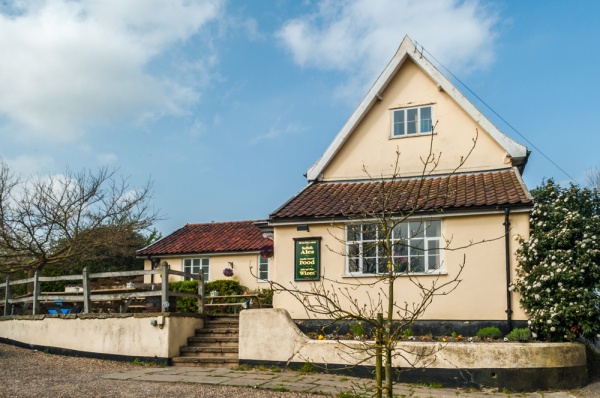
Wingfield is a small village with a big history. Tucked away down quiet lanes just south of the River Wavenay, Wingfield has 29 listed buildings, many of them dating to the medieval period, a testament to the long and rich history of the village.
There was very probably a settlement here in the early Saxon period, in the low-lying ground near the Strad Brook. The settlement probably took its name from a local family named Winga, or something similar.
From those small beginnings something rather special happened. By the 14th century the village was home to the Wingfield family, who took their name from the settlement.

In 1361 Sir John de Wingfield died and left money to found a college of priests, who would provide chaplains to say Mass daily for his soul. The college founded by Sir John became Wingfield College, and aside from praying for Sir John's soul, the college provided parish priests for the village and the surrounding parishes. They also had an educational function, preparing students for entrance into university.
Sir John was buried in the chancel of what is now St Andrew's church, beside the college. The church nave was completed by his son-in-law, Sir Michael de la Pole, who married his only daughter Katherine. Sir Michael died in 1415 at the Siege of Harfleur and is commemorated by an elaborate memorial in the chancel, near that of his father-in-law. Unusually, the effigies of Sir Michael and of Lady Katherine are made of wood.

No wood for John de la Pole, Duke of Suffolk (d. 1491) and his wife Elizabeth Plantagenet, sister of both Edward IV and Richard III; both their effigies are carved from alabaster. Sir John's head lies on a Saracen's head and helmet.
The Wingfield and De la Pole memorials are the historic highlights of what must surely be one of the finest country churches in East Anglia, if not all of England. Aside from the memorials, there is a medieval parclose screen, 15th-century misericords and carved choir stalls, an early 15th-century octagonal font carved with lions, and a peculiar wooden shelter called a 'hudd', made to protect the priest during burial services in the rain.
The De la Poles lived at Wingfield Castle, north-west of the church. The castle began as a manor house, but in 1384 Sir Michael de la Pole received permission to crenellate his family home, making it easier to defend, and at the same time making a statement about his family's wealth and status. Though it goes by the name of 'Castle', it is really a very large fortified manor house.

In 1510 the medieval manor house was pulled down and in 1540 the present building erected in one corner of the old fortifications. The castle is approached by a bridge over a moat, leading to a large Tudor gatehouse decorated with coats of arms to the Wingfield and De la Pole families.
From the De la Poles the Castle passed to the Catlin family of Norwich. From the Catlins it passed by marriage to the Turners, Baronets of Warham. Through the 19th and 20th centuries it was sold numerous times and is still in private hands. The Castle is, unfortunately, not usually open to the public, but you can get a good glimpse of it from the main road.
Across from the church is the village pub, rather aptly named the De la Pole Arms (formerly the King's Head). The inn dates to the 16th century and is timber-framed, though the Elizabethan timbers are largely hidden under a plastered exterior. To one side are 19th-century brick stables. The pub was in the news in 2012 when the Duke and Duchess of Cambridge stopped there to celebrate the wedding of a family friend.

Beside the churchyard is Wingfield College, mentioned earlier. The college was dissolved by Henry VIII and most of it was torn down in 1542. In the 18th century, the surviving wings of the college buildings were remodelled in Palladian fashion. In recent years the College has served as an arts venue, holding concerts and art exhibitions, but is now a private home once more.
The College is set in four acres of restored gardens. It was included in Simon Jenkin's popular Book, 'England's Thousand Best Houses'. As of this writing, the College is open under the Invitation to View scheme.
Wingfield is the sort of place where the past seems very close to the surface; the sort of place you want to linger and soak up the atmosphere. It is one of the most interesting small villages in Suffolk, and full of historic interest.
About Wingfield, Suffolk
Address: Wingfield,
Suffolk,
England
Attraction Type: Village
Location: On minor roads off the B1118, about seven miles east of Diss
Location map
OS: TM228771
Photo Credit: David Ross and Britain Express
HERITAGE
 We've 'tagged' this attraction information to help you find related historic attractions and learn more about major time periods mentioned.
We've 'tagged' this attraction information to help you find related historic attractions and learn more about major time periods mentioned.
Find other attractions tagged with:
NEARBY HISTORIC ATTRACTIONS
Heritage Rated from 1- 5 (low to exceptional) on historic interest
Wingfield, St Andrew's Church - 0.2 miles (Historic Church) ![]()
Stradbroke, All Saints Church - 2 miles (Historic Church) ![]()
Fressingfield, St Peter & St Paul's Church - 2 miles (Historic Church) ![]()
Hoxne, St Peter & St Paul Church - 3 miles (Historic Church) ![]()
Horham, St Mary's Church - 3.1 miles (Historic Church) ![]()
Wilby, St Mary's Church - 3.3 miles (Historic Church) ![]()
Billingford Mill - 3.9 miles (Historic Building) ![]()
Metfield, St John's Church - 4.5 miles (Historic Church) ![]()



